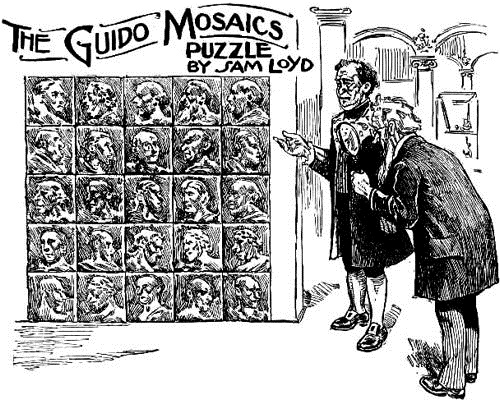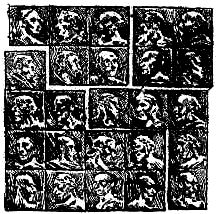



IT IS NOT GENERALLY known that the celebrated piece of Venetian mosaic by Domechio, known as the Guido collection of Roman heads, was originally divided into two square groups, which were discovered at different periods. They were brought together and restored into what is supposed to be their correct form, in 1671. Considerable discussion was aroused regarding the possibility as well as appropriateness of uniting the collections of 25 heads into one square, as it now exists, when, apparently by accident, it was discovered that each of the two squares consisted of several pieces which would fit together into one 5x5 piece as shown.
It is a pretty puzzle, and as all puzzles, like mathematical propositions, can be worked backwards to advantage at times, we will reverse the problem, and ask you to divide the large square into the fewest number of pieces which can be refitted into two squares which conform to the conditions described.
This puzzle is given as differing from the Pythagorean principle of cutting lines on the bias, for, while we know that by the theory of the hypotenuse line two squares can be divided so as to produce one larger square, and vice versa, it is assumed in this puzzle that we must cut on the lines only, so as not to destroy the heads. It may also be mentioned incidentally, that students who have mastered the principles of square root, as explained in the Pythagorean problem, will not find much difficulty in discovering the same old theory cropping up among the Roman antiques, to tell them how many heads there must have been in the smaller squares which saves considerable experimental work.
As a lesson in puzzle construction it may be said that problems of this kind which call for the “best” answers, in the “fewest number of pieces.” etc., offer great scope for cleverness. Anyone might find a solution in many pieces, or which stands some of the old Romans upside down.
This puzzle is based upon that famous 47 problem of Euclid which proves that the squares of the side and base must equal the square of the hypotenuse. We here see that 3 square and 4 square equal 5 square:

2.
Why is the emblem of the United States more enduring than that of France, England, Ireland, or Scotland?
The Lily may fade and its leaves decay,
The Rose from its stem may sever,
The Shamrock and Thistle may pass away,
But the Stars will shine forever.
Why is a kiss, like a sermon? Because it needs two heads and an application.
When two people kiss, what, kind of a riddle does it make? A rebus.
What is it George Washington seldom saw, God never saw, and we see every day? Our equals.
Prove by logic that an oyster is better than heaven.
Nothing is better than heaven,
an oyster is better than nothing;
therefore an oyster is better than heaven.
What is the difference between a honeymoon and a honeycomb? One is a big sell, the other little cells.
Why is a man who makes pens a wicked man? Because he makes men steel (steal) pens and then says they do write (right).
[Page 98]